ELK AND LITTLE KANAWHA RAILROAD BROUGHT LIFE AND COMMERCE (4/3/00)
By Bob Weaver
The Elk and Little Kanawha Railroad sprung to life between 1910-13, serving to transport oil barrel staves and wood
products from the large holdings of the Interstate Cooperage Company, a division of Standard Oil. The "Bear Fork"
timbering operations in Braxton, Gilmer and Calhoun, covered at least 28,000 acres, bought from the Bennett heirs.
The railroad connected Gassaway, Frametown, Rosedale, Shock, much of it along Steer Creek and deep into the
Bear Fork Country. At least eight miles of track extended into Calhoun County, up and down the narrow hollows,
climbing several steep grades.
The original railroad company built a depot and roundhouse near the mouth of Little Otter Creek, near the Little
Otter Baptist Church (1895), and the Elk and Little Kanawha Railroad maintained a stave yard at Gassaway, where
they would be loaded on the coal and coke cars for market.
Railroad construction was started in 1910 into the rich timber land which also has large deposits of Freeport Coal.
The Boxley's were the main contractors on the project, although many other smaller companies received contracts.
Annie Harvey Dulaney reported that the contractors came by train, bringing their labor force, mules, and equipment
for the laborious undertaking, with much of the roadbed created by blasting.
A huge cut was made at Big Run Hill, although original plans called for a tunnel. One of the first sections was laid to
Grose, near the Henry Dickey farm. The Village of Grose had mills, a store, and several houses.
Rosedale had one of the three depots, located across Steer Creek from the main village. It was near the Stewart
Wright House and not far from a lamp black factory. About 1912-13 the tracks extended down Steer Creek toward
Shock, at the Mouth of Tanner, where a third depot was constructed. (SEE "Yes, Virginia, Calhoun Did Have A
Railroad" - Tales Of Bear Four: Part Four in The Hur Herald)
Frank Fisher was the storekeeper and Postmaster at Shock. Anna Harvey Dulaney records some of the residents
and workers from Shock: Henry Gumm, office manager, Henry Badgett, Pete Boggs, Ned Hopkins, Berne Conrad,
Newton Moore, the Norman and Uldrich families.
The Elk and Little Kanawha Railroad, which at one time had a vision of going all the way to Parkersburg, was in
operation by 1912. The right-of-way was obtained through a "public carrier" law which required the line to haul both
people and freight. The work camps held Swedes, Blacks, Italians and many other nationalities.
Gaylen Duskey has related to us that his grandmother, Madge Burns, told of Chinese (I think they were Chinese)
workers complaining of illness. After investigating they figured that the problem was the workers had been eating
owls since they commented "too many big-eyed chicks."
The construction company provided some good wages for local farmers and construction workers, up to $1.60 a day
for laborers and $2.10 for a mill worker. Foster Norman, the water boy, made seventy-five cents a day. Goods and
supplies were purchased from local merchants, greatly increasing their businesses.
Dulaney said that the railroad began to sink as America began to go to World War I. By 1917 the Braxton County
and Bear Fork timber operations had been completed. In 1918 the track was taken up and the Gassaway roundhouse
and depot were washed away by a flood.
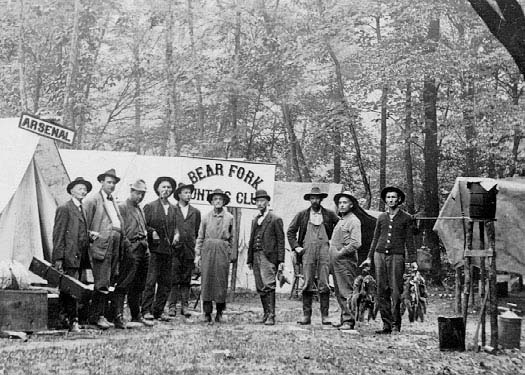
Bear Fork Hunting Club Early 1900's
Can any of our readers identify any of the members pictured?
If so please contact us.
Extensive oil and gas development has occurred in the Bear Fork Region during much of the 20th century, but much
of the backwoods is still remote to be enjoyed by longtime members of the Bear Fork Hunting Club.
"It is now a memory of a brief and colorful existence which forms a part of the history of Braxton County," said
Dulaney. - Bob Weaver
EDITOR'S NOTE: Our thanks to the writing of Annie Harvey Dulaney and Harlan Stump for information used in this
piece. It has been a fascinating two days traveling along the old railroad bed, talking with folks along the way, and
remembering a time past.
BEARFORK OLDTIMERS: THE WOOD FAMILY (4/4/00)
One on the more memorable of the families who lived in Bear Fork was the Wood family, more specifically, Thomas
Avery "Ole Avery" Wood and his family.
Avery was born in North Carolina and arrived in Calhoun County from Montana some time after his father, William
H. Wood.
The first of the Wood family, William H. Wood (Avery's father), arrived here prior to 1880. William H., according to
family oral history had been a Confederate soldier in North Carolina during the Civil War. He was captured by Union
troops and "turncoated."
Following the war, he returned home to North Carolina but was not accepted by his family.
He apparently was married in North Carolina for Avery gives his birthplace as North Carolina. Family historians
believe he came into West Virginia at Servia in Braxton County where he bought store goods and became a
huckster.
From there he came to Calhoun, settling on Daniels Run with a Post Office address of Claria. Here, along
with his son (probably George from his second marriage), he later engaged in establishing a mill.
In 1879 William married a second time to Roberta Leach, daughter of Enoch and Mary Leach. The newlyweds were
living with her parents at the time of the 1880 Census.
From this second marriage there were five children: Maggie who married John T. Crawford; George who married
Ola Newell; Oma Esther who married Willie Crawford; Etta who married J.B. Booher; and Laura who married Guy
Nitz.
Oral history also says Avery arrived from Montana where he had been married and had a family. The marriage ended in
divorce and the children remained in Montana with their mother. Avery was said to have arrived with a horse
(possibly "borrowed") and saddle. With him he also brought a tintype of his family in Montana but, unfortunately, it
was destroyed when the Woods' home burned in 1949.
Following his arrival in Calhoun/Gilmer Counties about 1914, Avery may have, for a time, lived in a cave in Bear
Fork.
Listed as a widower, in 1918 he married Viola Umstead, a hardened mountain woman and daughter of George and
Florence Umstead. Together they established their home, a log cabin, near the mouth of Fern Hollow, two miles
from the main road (U.S. 33/119) up in the deep woods along main Bear Fork. It was known as the "ole Mathew's
place."
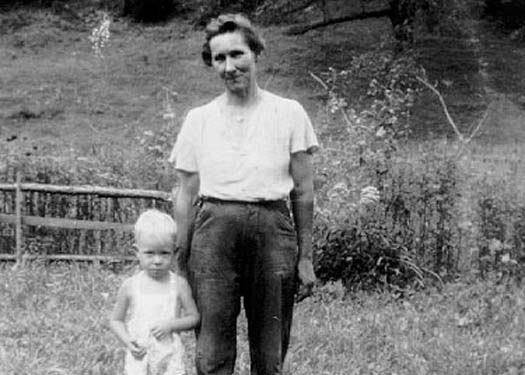
Viola Umstead Wood
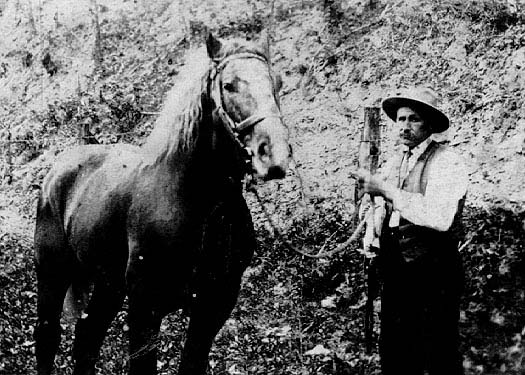
Thomas Avery Wood
Here they lived until the cabin burned to the ground in 1949.
The log structure was located next to the narrow gauge railroad that hauled barrel staves to the main road for the
Interstate Cooperage Company. It was here the family grew and he and Viola raised their children, three girls and
five boys, including current Calhoun resident, Guy Woods, 81, of Daniels Run. Guy has stated that the railroad was
gone before his time.
The Avery and Viola Woods family consisted of the following children: Guy who married Velma Booher; Warren
"George" married Betty ? and Lenora ?; Denver married Mollie Shaffer; Romeo married Betty Harris and Carol ?
from PA; Thelma married Harold Shaffer then Bill Wire; Maggie married Clark Burrows; Thomas Avery, Jr. "Pete"
married several times, his first wife being Sharon Wilson; and O'Dell married Ruby Tallhammer.
Avery farmed, raised cattle and hunted. While the family was less than prosperous, their needs were simple and like
many Calhoun families of the time they "got by."
Just "getting by" was more difficult for Avery than for most. He labored under the handicap of having lost his right
arm when but a small lad while feeding a cane mill in Trap Hill, NC.
Avery, frequently left the dark woods to acquire store goods and at such times visited family and friends before
returning home. His attire is remembered as always consisting of a white shirt, galluses (Hurbonics definition:
suspenders), dark pants and gum boots.
Remembered by family as a happy, jovial fellow, he often was known to entertain by playing his mouth organ and
dancing. This was said to be a most entertaining sight when performed wearing his ever present gum boots.
A frequent visitor at the home of Robert J., Sr. and Lillie Knotts, Avery often stopped after dark on his way back to
his Bear Fork home. Always polite and well-mannered, he usually arrived sometime after the rest of the family had
eaten their supper. As Lillie cleared the table following the family's evening meal, she was often was heard to
comment. "I'll just set this on the back of the stove for now. Avery just might drop by." Often he stopped, ate his
supper; sat and visited a spell and went on his journey into the deep woods.
After Avery's death, Viola occasionally visited Lillie Knotts, who by this time was bedridden following a stroke.
For many years he traveled by horse, a huge animal more suited to timbering, farm work or teamstering than as a
saddle horse. Following the demise of the great beast, his mode of transportation was by Shank's Mare (Hurbonics
definition: walking).
Following the loss of their home by fire, Avery and Viola lived with various family members for a time. Later, they
lived in a jenny lind house constructed near the site of the former log cabin.
In 1960, eight years after the death of her husband, Avery, Viola passed away. Together they sleep, side by side, in
the Sand Ridge Cemetery.
EDITORIAL NOTE: The Hur Herald wishes to thank Frances Starkey, Darrell Wood and Guy Wood for their
assistance the writing of this segment.
THE RAILROAD COMETH (4/13/00)
The Elk and Little Kanawha Railroad, like many narrow-gauge railroads in the mountains, was quite an engineering
feet for 1910. Steep grades, deep cuts, trestles and numerous switch-backs made it operational. The original
construction company went bankrupt and Interstate Cooperage, a division of Standard Oil, took over the operation
for their stave business and kept it going until 1917, when the tracks were removed.
In an earlier Bear Fork Tales, it was written that the railroad, besides covering much of the Bear Fork backwoods,
extended into Calhoun County at least eight miles, a fact that few people in Calhoun are aware.
Normantown resident and historian, Ron Miller, recently took us on a trip, tracing the path of the the E and LK from
Gassaway to the Left Hand of the West Fork of the Little Kanawha (Orma-Nicut), among numerous other places.
Miller and Don Norman have done research on the railroad, and Miller has collected a number of pictures, which we
intend to publish in The Herald.
We went to Gassaway to the mouth of Little Otter at the Elk River, site of the original depot and turntable, which
was washed away in the flood of 1918. It was here that the company connected with the standard gauge that ran from
Charleston to Sutton, originally built as the Charleston, Clendenin and Sutton Railroad in 1895.
In 1902 it was sold to the Coal and Coke Railroad Company, owned by Henry Gassaway Davis, and was sold again in
1912 to the B & O. We will be printing Miller's early photos of the depots at Gassaway, Rosedale and Shock.
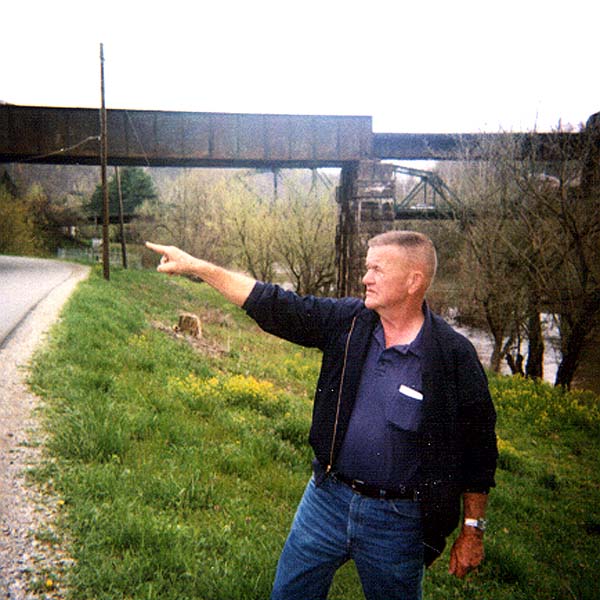
Miller Stands At Gassaway/Little Otter Site of
E & LK Station
The E and LK ran through an area "hungary for transportation," carrying passengers, general freight and millions of
barrel staves, which were transferred from the narrow gauge to the main line at Gassaway.
From Gassaway to Shock, the road bed can still be spotted, although the track often follows our current roads.
Remnants of culverts, high bridge fills, bridge piers, and deep cuts are evident. A deep cut between Frametown and
Rosedale, originally planned as a tunnel, is the "Big Run Cut," at the top of a steep mountain.
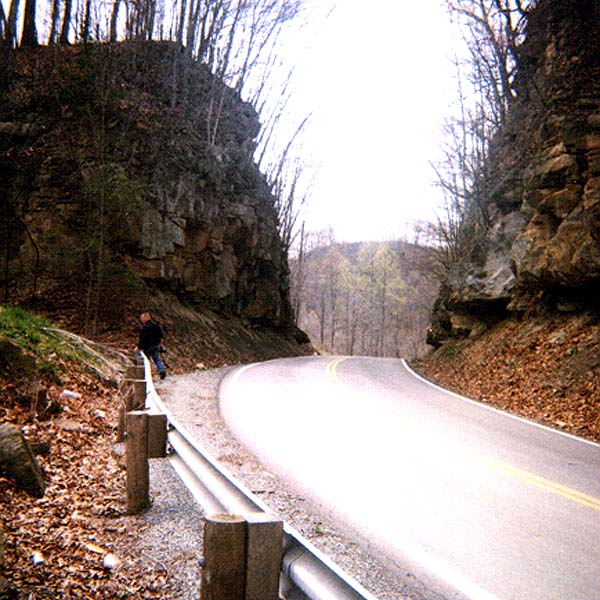
"The Big Run Cut" Frametown-Rosedale
Road
Traveling through Rosedale, Ron Miller, recalls with detail the location of buildings in the once prosperous town,
brought to the forefront by an oil and gas boom before the coming of the railroad in 1910. Rosedale had a carbon
black factory, like Grantsville, and a Mayor to preside over its numerous residents, hotel, stores, and the train depot
near Steer Creek.
Some stories suggest the E and LK railroad was to have continued to Russett, where it would have joined another
Little Kanawha railroad company which planned a line between Parkersburg and Burnsville. Neither got built.
Miller, who was born "up on Tanner," remembers the train depot building at Shock near the 1840 log cabin (SEE
earlier Hur Herald). "The train left Steer Creek at Shock and shot up Tanner," he said, pointing out the several
landmarks, including the office building for the Cooperage Company.
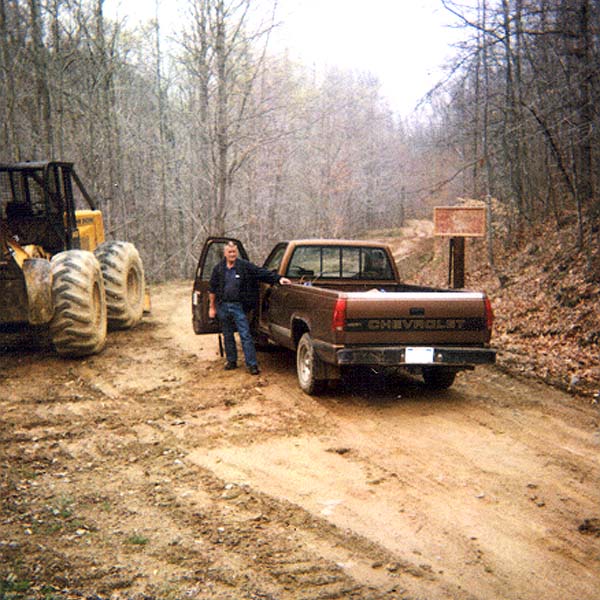
Railroad Entered Bear Fork At Head Of
Right Fork Of Tanner
The narrow-gauge wound its way up narrow "Tanner" to take up the Left Fork toward the Gilmer-Calhoun line,
turning left into the nearly 30,000 acre Bear Fork deep woods, on the hillside not far from the top of the hill. The
railroad, however, continued up the hill to the present Frozen Community Church, where a switchback was installed,
before the decline down on main Frozen Run and into Calhoun County.
The Bear Fork line, which we are currently mapping, covered much of the wilderness area and extended into
Calhoun through the "Deep Gap" near Sugar Camp and down the Right Fork of Crummies Creek two to three miles
to a saw mill.
Much of the main line went along main Bear Fork Creek, following the stream to its mouth, coming out of the
backwoods on U.S. 33/119 and down to Steer Creek, near the intersection of U.S. 33/119 and the Russett/Grantsville
Road near Stumptown.
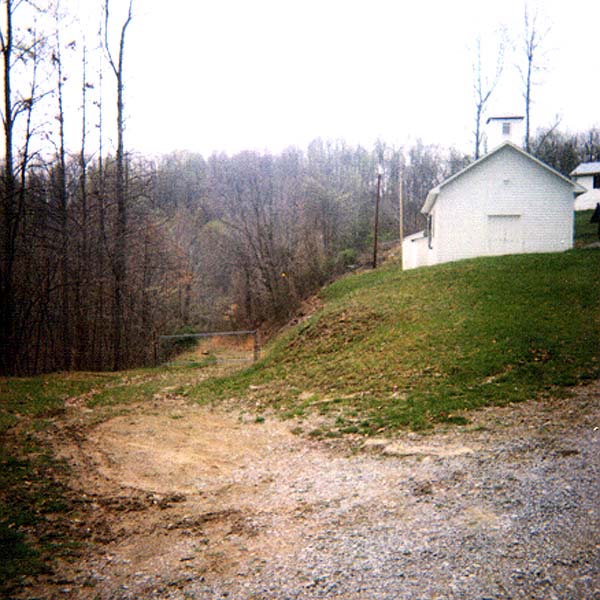
Switchback On Side Of Hill
Near Frozen
Church
At the foot of Frozen Hill (head of Frozen) was an intricate devising of switchbacks, one going up the Claude Rogers
Hollow. We were going to interview Mr. Rogers about his Bear Fork stories, but unfortunately he passed on before
our appointment.
To the right of the Roger's hollow is the still standing Frozen Post Office. Ron Miller said it was built in the late 30's
or early 40's by Johnny Cottrell, who was a postmaster. The E and LK took down Frozen in front of the old post
office, essentially following the current roadway. Tracks also went up Spruce, not far from the mouth of Frozen.
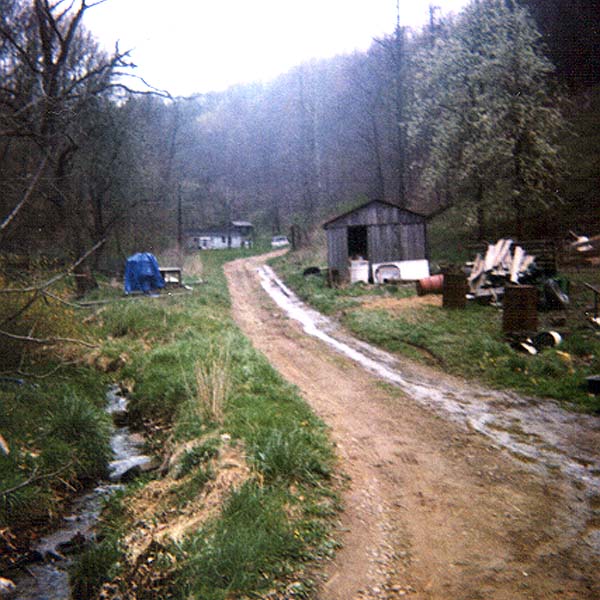
Switchback (Road)
Up Claude Rogers Hollow
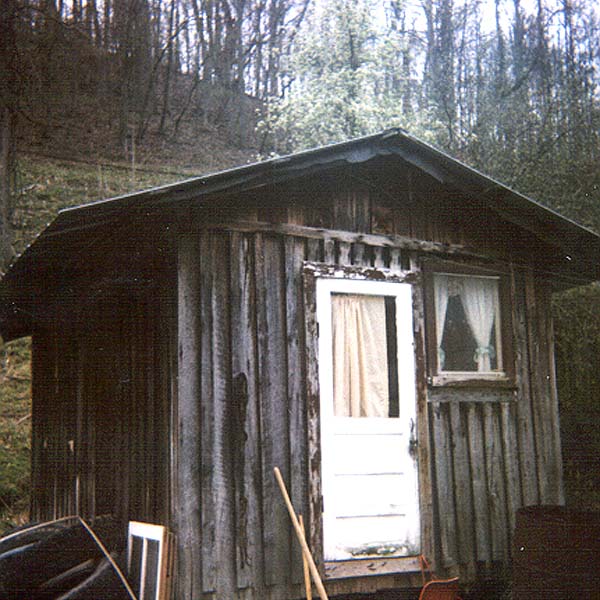
Johnny Cottrell's
Frozen Post Office, Head
Of Frozen
The E and LK went down to the mouth of Frozen, past the Knotts and Lauson Store (SEE "Yes, Virginia, Calhoun
Did Have A Railroad'), and went up Left Hand about .6 miles to the "Downey place," not far from the mouth of
Upper Big Run."Left Hand" is the main road from Orma to Euclid to Nicut, and is the Left Hand of the West Fork of
the Little Kanawha River.
The railroad had a short-lived history, but contributed much to the lives of many families who lived in the backwoods
of Braxton, Gilmer and Calhoun Counties. Foster Norman (1896-1976) told of riding the railroad from Shock when he
went away to World War I in 1917. He expected to ride it home when he returned in 1919, but to his surprise the
track had been taken up, back to Wilsie. - Bob Weaver www.hurherald.com
EDITOR'S NOTE: We express our sincere appreciation to Gilmer County historian and most excellent chap, Ron
Miller for his day tour of the old E and LK road bed, and information collected by Don Norman of Steer Creek and
the late Harlan Stump of Millstone. I do regret not having a tape player to record the "tons" of oral history that flows
from Ron Miller's lips. Maybe next time. We intend to publish several pictures of the railroad, which Ron is
providing, and our "first edition" Elk and Little Kanawha Railroad Map with lots of other information and landmarks
of the greater Bear Fork backwoods.
| 


